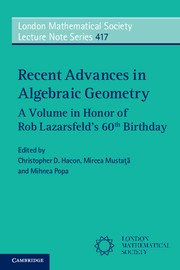Book contents
- Frontmatter
- Contents
- List of contributors
- Preface
- 1 The effect of points fattening in dimension three
- 2 Some remarks on surface moduli and determinants
- 3 Valuation spaces and multiplier ideals on singular varieties
- 4 Line arrangements modeling curves of high degree: Equations, syzygies, and secants
- 5 Rationally connected manifolds and semipositivity of the Ricci curvature
- 6 Subcanonical graded rings which are not Cohen–Macaulay
- 7 Threefold divisorial contractions to singularities of cE type
- 8 Special prime Fano fourfolds of degree 10 and index 2
- 9 Configuration spaces of complex and real spheres
- 10 Twenty points in ℙ3
- 11 The Betti table of a high-degree curve is asymptotically pure
- 12 Partial positivity: Geometry and cohomology of q-ample line bundles
- 13 Generic vanishing fails for singular varieties and in characteristic p > 0
- 14 Deformations of elliptic Calabi–Yau manifolds
- 15 Derived equivalence and non-vanishing loci II
- 16 The automorphism groups of Enriques surfaces covered by symmetric quartic surfaces
- 17 Lower-order asymptotics for Szegö and Toeplitz kernels under Hamiltonian circle actions
- 18 Gaussian maps and generic vanishing I: Subvarieties of abelian varieties
- 19 Torsion points on cohomology support loci: From D-modules to Simpson's theorem
- 20 Rational equivalence of 0-cycles on K3 surfaces and conjectures of Huybrechts and O'Grady
- References
18 - Gaussian maps and generic vanishing I: Subvarieties of abelian varieties
Published online by Cambridge University Press: 05 January 2015
- Frontmatter
- Contents
- List of contributors
- Preface
- 1 The effect of points fattening in dimension three
- 2 Some remarks on surface moduli and determinants
- 3 Valuation spaces and multiplier ideals on singular varieties
- 4 Line arrangements modeling curves of high degree: Equations, syzygies, and secants
- 5 Rationally connected manifolds and semipositivity of the Ricci curvature
- 6 Subcanonical graded rings which are not Cohen–Macaulay
- 7 Threefold divisorial contractions to singularities of cE type
- 8 Special prime Fano fourfolds of degree 10 and index 2
- 9 Configuration spaces of complex and real spheres
- 10 Twenty points in ℙ3
- 11 The Betti table of a high-degree curve is asymptotically pure
- 12 Partial positivity: Geometry and cohomology of q-ample line bundles
- 13 Generic vanishing fails for singular varieties and in characteristic p > 0
- 14 Deformations of elliptic Calabi–Yau manifolds
- 15 Derived equivalence and non-vanishing loci II
- 16 The automorphism groups of Enriques surfaces covered by symmetric quartic surfaces
- 17 Lower-order asymptotics for Szegö and Toeplitz kernels under Hamiltonian circle actions
- 18 Gaussian maps and generic vanishing I: Subvarieties of abelian varieties
- 19 Torsion points on cohomology support loci: From D-modules to Simpson's theorem
- 20 Rational equivalence of 0-cycles on K3 surfaces and conjectures of Huybrechts and O'Grady
- References
Summary
Abstract
The aim of this paper is to present an approach to Green–Lazarsfeld'sgeneric vanishing combining Gaussian maps and the Fourier–Mukai transform associated with the Poincaré line bundle. As an application, we prove the generic vanishing theorem for all normal Cohen–Macaulay subvarieties of abelian varieties over an algebraically closed field.
Dedicated to my teacher, Rob Lazarsfeld, on the occasion of his 60th birthday
1 Introduction
We work with irreducible projective varieties on an algebraically closed field of any characteristic, henceforth called varieties. The contents of this paper are:
(1) A general criterion expressing the vanishing of the higher cohomology of aline bundle on a Cohen–Macaulay variety in terms of certain first-order conditions on hyperplane sections (Theorem 2). Such conditions involve Gaussian maps and the criterion is a generalization of well-known results on hyperplane sections of K3 and abelian surfaces.
(2) Using a relative version of the above, we prove the vanishing of higher direct images of Poincaré line bundles of normal Cohen–Macaulay subvarieties of abelian varieties (Theorem 5). As is well known, this is equivalent to Green–Lazarsfeld's generic vanishing, a condition satisfied by all irregular compact Kahler manifolds [5]. This implies in turn a Kodaira-type vanishing for line bundles which are restrictions to normal Cohen–Macaulay subvarieties of abelian varieties, of ample line bundles on the abelian variety (Corollary 6).
Concerning point (2), it should be mentioned that at present we are not able to extend this approach efficiently to the general generic vanishing theorem (GVT), i.e., for varieties mapping to abelian varieties, even for smooth projective varieties over the complex numbers (where it is well known by the work of Green and Lazarsfeld). This will be the object of further research. However, concerning possible extensions of the general GVT to singular varieties and/or to positive characteristic, one should keep in mind the work of Hacon and Kovacs [8] where – by exploiting the relation between GVT and the Grauert–Riemenschneider vanishing theorem – they show examples of failure of the GVT for mildly singular varieties (over C) and even smooth varieties (in characteristic p > 0) of dimension ≥ 3, with a (separable) generically finite map to an abelian variety.
- Type
- Chapter
- Information
- Recent Advances in Algebraic GeometryA Volume in Honor of Rob Lazarsfeld’s 60th Birthday, pp. 370 - 404Publisher: Cambridge University PressPrint publication year: 2015



